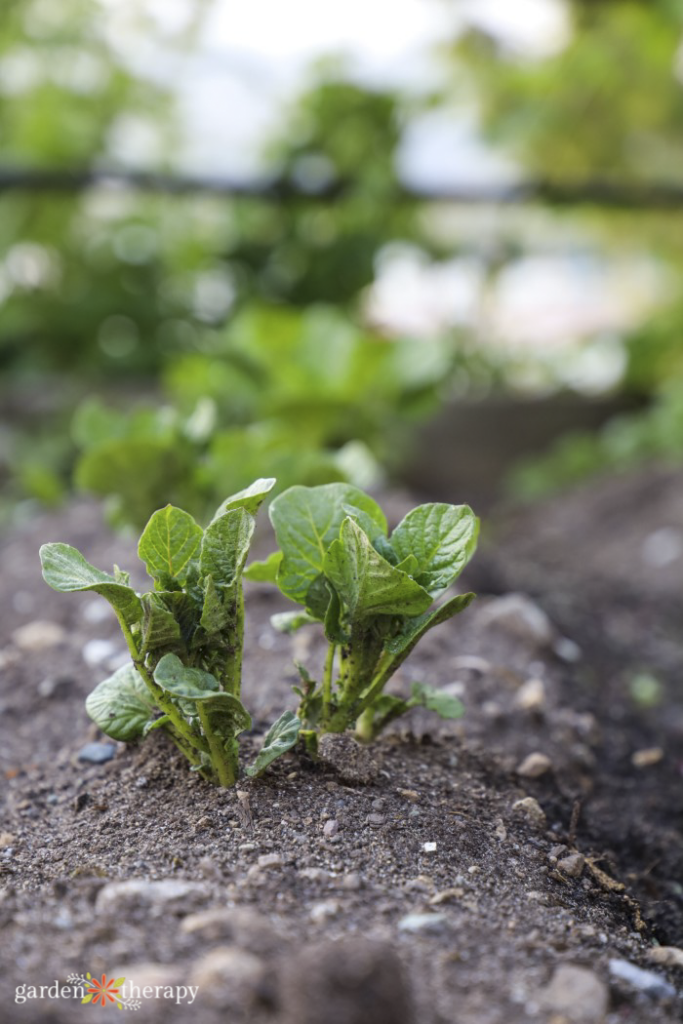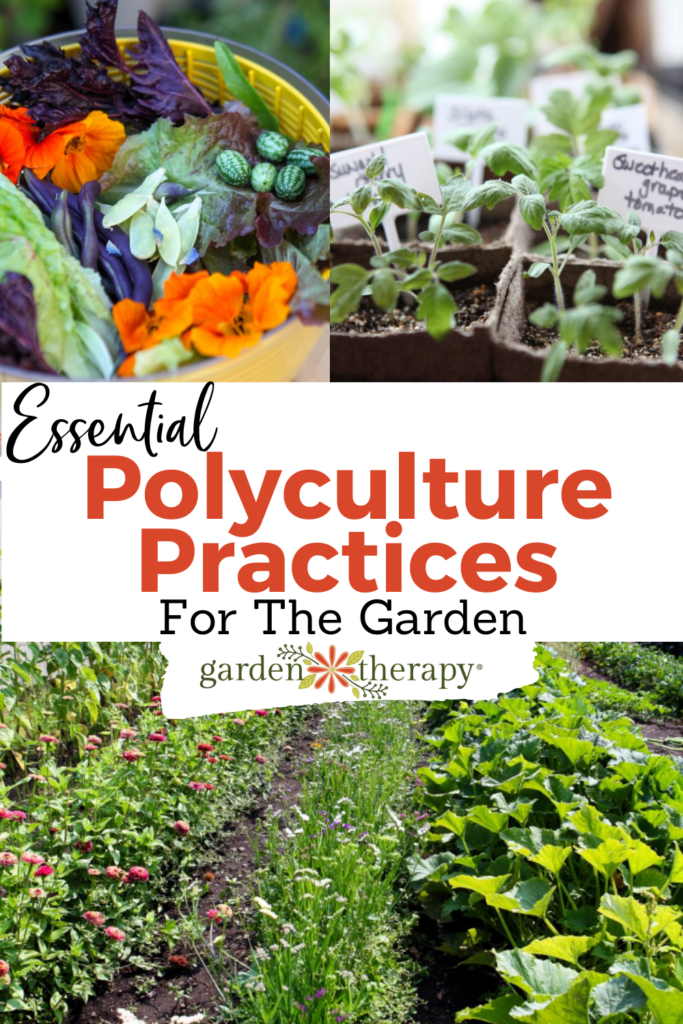With the rise of organic farming and localized food movements, we’re slowly changing how we interact with nature. Old practices are becoming new again, once again bringing forward the rise of polyculture gardening. By planting different varieties and species of plants, we can set up the garden for better diversity and resilience. Trust me, it’s not as hard as you may think!

People often ask me, “How do I build a polyculture garden?” In reality, that question doesn’t make sense. Polyculture is a method of growing, not a type of garden you can build.
In gardening, we can practice monoculture, where we only grow one plant in an area. Alternatively, there’s polyculture, where we grow many plants. Some refer to polyculture gardens as guilds or food forests. But those are not the same things!
If you’re confused, don’t worry. This post will really break down everything you need to know about employing polyculture practices in your garden. Likely, you’re already practicing it to some extent!
This post will cover…
Polyculture is one of the main practices I discuss in my book, The Regenerative Garden. Inside, you’ll find over 80 projects that you can try in your own garden. Deeply rooted in permaculture practices, it allows you to take your garden one step further towards becoming more sustainable, diverse, and self-reliant.
Polyculture vs Monoculture
Monoculture is when you only grow one crop at a time in a specific area. Typically, farmers will grow plants that thrive in their specific weather conditions and microclimates. They can focus on one crop at a time and not worry about varying planting schedules, maintenance, and harvest times.
Growing these main plants is the simplest way to keep up with the demand for food. It allows farmers to specialize in one crop, understanding its needs to thrive and unique problems to solve. This reduces costs and increases profits. The concept can also be applied to livestock.
Polyculture planting, on the other hand, is where you simultaneously grow different crops at once in the same area. By pairing complementary plants, they no longer battle for the same resources and nutrients and have the same weaknesses. This can result in increased biodiversity, better productivity, fewer pests, and better soil. It’s also a great insurance plan, as if one crop fails, there’s another to harvest.
Also known as intercropping, you can apply polyculture practices everywhere, from a kitchen garden to a full farmer’s crop. Planting vegetables that are ready for harvest at different times, succession planting, and sowing multiple varieties of each vegetable are all part of growing a polyculture garden.
For example, the indigenous people of America used the Three Sisters method of growing beans, corn, and squash together. The corn provided support for the beans to grow upwards, beans provided nitrogen, and squash covered the ground to prevent weeds and retain moisture.

Why is Polyculture Better Than Monoculture?
Throughout history, polyculture methods were much more common. Now, monoculture practices have taken over in Westernized countries. Humans went from harvesting perennial plants in polyculture practices to monoculture practices favouring annual plants.
Monoculture cropping is done to manage large volumes of production of one crop at a time, but it comes with many problems. Overproduction of one crop can lead to waste of what cannot be used or sold before it spoils.
It invites pests and disease problems to thrive. Most pests and diseases have preferred plants and environments and will home in on their favourites. If they find a full crop of food they like, they’ll come in, eat, and reproduce more efficiently. This leads to an increased need for pesticides.
Monoculture practices also deplete the soil of the nutrients the crop needs since the plants all require the same type and amount of nutrients. This can also decrease bacterial and microorganism varieties to keep the soil fertile. This results in a higher need for synthetic fertilizer. Soil erosion is also more likely as it requires multiple root levels to be stopped.
These problems are quickly beginning to outweigh the benefits, and farmers are returning to polyculture, planting many species and varieties of crops to more closely follow the natural processes of nature. These polyculture practices can work wonders in the home garden as well.
Are There Any Disadvantages of Polyculture Gardening?
Yes, there are a few reasons why farmers and bigger entities favour monoculture practices. Because you’re going to have multiple plants in one area, it makes things more time-consuming for the farmer. It becomes more difficult to plant and harvest these plants as they may have different harvest times and require different tools.
Planning can also get complicated. You need to research companion planting, as some plants don’t like being near others. You need to understand the needs of all the plants and their plant families for growing.
Monoculture also tends to bring forward easier yields as you can create the perfect conditions for that specific plant that may not be as ideal for others. However, if you do your research, you can still get very high yields from a polyculture garden.
I get it. I know why farmers want to grow monoculture gardens. It makes their life easier and gives them the best bang for their buck. But sometimes, the easy way isn’t always the best way. When it comes to the garden, however, polyculture practices are much less difficult to do.

How to Use Polyculture Methods in Your Garden
Here are some tips for creating biodiversity of plants that will allow for more fruitful harvests and gardens.
- Sow seeds densely and eat what you thin.
- Plant several varieties. One or two may perform better than others.
- Reserve a minimum of 30% of the best plants for seed saving.
- Plant fast-growing edible plants and plants that take a long time to mature.
- Plan varieties to ripen at different times to extend the harvest. Plant early and late-season varieties.
- Sow seed varieties that mature at the same time every week or two, so they are ready for harvest every week or two.
- Plant groundcovers below tall sun-loving plants. Ground cover plants help prevent bare earth and suppress weeds.
- Research plant partners. Plant varieties that help each other grow, ripen, or stay safe from pests and disease.
- Plant deep-rooted plants with shallow-rooted plants.
- Mix plant families and species to discourage disease and pests from coming back in future years.
- Plant annuals around young perennials as they fill in the space and mature over the years.

Polyculture Gardening FAQ
Here’s an example of how you could easily implement polyculture practices into your vegetable garden. Grow one row of vegetables, then a row of a different vegetable. Try to intermix as much as possible, and sow another round of vegetables weeks later to stagger the harvest.
Between your vegetables, add herbs and flowers. Many herbs and flowers can help keep pests away by masking the smell or even attracting the pests to themselves rather than your vegetables (these are known as trap crops).
Overtop, you might have larger fruit or nut trees, as well as shrubs, perennials, and vines along the edges. These can be edible too, or provide habitat for beneficial insects.
A polyculture is where you grow different plants in the same area at the same time. You grow complementary plants, and in turn, increase biodiversity and productivity.
Meanwhile, permaculture is another gardening practice where you design a garden to be productive all on its own. It mimics natural and local ecosystems and focuses on sustainability.
Intercropping and polyculture gardening are the same thing. It’s where you mix complementary plants together in the same area.
Intercropping is beneficial because it helps to support the soil rather than deplete it. Plants aren’t competing for the same nutrients, which limits the need for synthetic fertilizer. It also prevents soil erosion.
Intercropping also results in fewer pests. Since most pests have preferred foods, they will come in and devour entire crops when they find a large supply of their favourite plants. Certain plants can also deter pests, and be mixed in amongst the crops.
Interested in learning more about polyculture gardening and how to create a thriving ecosystem in your own yard? I invite you to check out The Regenerative Garden, where I give more than 80 different projects and ideas to do just that!
More Gardening Practices to Try
A city girl who learned to garden and it changed everything. Author, artist, Master Gardener. Better living through plants.





